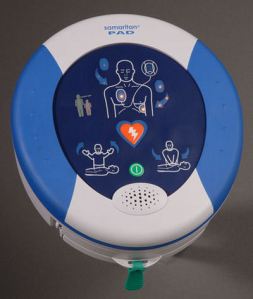AEDs: Use by Hospitals, Nursing Homes, and Healthcare Providers

Just what is the standard or duty to provide care of healthcare, long-term care or elderly care providers for Automated External Defibrillators (AEDs)?
From my consistent research and study of the AED industry, the standard appears to be that many nursing homes, elderly housing complexes or assisted living facilities still do not have an AED policy or program. In 2007 a summary study within the industry showed:
https://www.jamda.com/article/S1525-8610%2807%2900207-1/abstract
Contrarily, here is an Ohio-based Midwest article on AEDs & some facilities who have decided to implement AED programs: https://www.redorbit.com/news/health/358076/many_nursing_homes_lack_device_to_restart_heart_portable_defibrillators/
Now, not taken into consideration is the question regarding “duty to provide care” – and what is really the up-to-date 2014 standard to provide care as it relates to AEDs or CPR in these facilities?
* Are there any industry mandates taking place? What is the healthcare industry doing about AEDs?
* What are the trends for DNR orders or Attempted CPR- are the number of DNR orders going up or down as a % of population being admitted to healthcare facilities? Should nursing homes or long-term care facilities have solid AED programs in place due to a decreasing % of DNR orders and more patient preferences to attempt CPR?
In January 2010 there was a great article I read that showed how UCLA is implementing AED programs across their system, due to the improvement in SCA survival they offer. UCLA Article
I have also read many articles/studies in recent years on in-hospital SCA survival versus out-of-hospital survival and perhaps UCLA is trying to improve SCA survival and change the statistics, which show IN-HOSPITAL survival is lower than OUT-OF-HOSPITAL per many studies. The above link shows the obstacles facing nurses and staff and why AEDs may be a welcome addition to healthcare facilities.
Regarding long-term and elderly facility industry practices such as DNR advanced directives
are followed. But, methods for identifying CPR status need improvement to enable accurate identification and prompt resuscitation of residents who want CPR:
https://www.gnjournal.com/article/S0197-4572%2898%2990117-3/abstract
It is known that ACPR is infrequently performed in long-term care setting and is rarely successful (successful being defined as admission to the hospital alive). Survival (defined as discharge from the hospital) is also rare but survival does occur though. All nursing homes are not required to offer ACPR and many nursing homes in the United States, as well as in other parts of the world, do not offer ACPR.
In my assessment from my research, agencies such as the American Bar Association’s Commission on Law & Aging show that about two-thirds (2/3) of the adult population does not have an advanced directive or DNR. I could not find any recent studies to answer my DNR questions on DNR preferences.
Recent mandates or pending mandates and “encouraged use” Bills have passed in recent years in the following states that are for assisted living facilities or long-term and medical facilities: Texas, New Jersey, New York, Nevada, Florida and others.
Perhaps it will some day become an expectation for all long-term facilities to have an AED and perform CPR but for now, it appears that each facility has to make their own decision but for sure they should consider their state’s legislation or pending legislation as it affects licensing for their facility.
One excerpt of a study states, “Surveys have shown that many elderly in different parts of the world want to be resuscitated, but may lack knowledge about the specifics of cardiopulmonary resuscitation (CPR). Data from countries other than the US is limited, but differences in physician and patient opinions by nationality regarding CPR do exist.” In the essence of observing the opinions of those elderly that do want to be resuscitated – perhaps there will be some marketing advantage to employ by organizations that implement AED programs.
For a summary of up-to-date Nursing Home laws and examples of corporate position statements regarding AED programs, complete the following form!
Error: Contact form not found.

